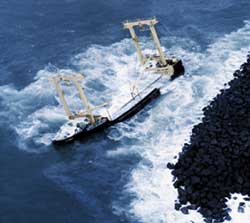In the Lab

Burn, Baby, Burn
Laboratory experiments, conducted at Penn State University, show that open water oil spills, previously thought to be incombustible, potentially can be cleaned up by burning.
"Oil spill combustion can be a highly effective clean up measure for contained spills occurring on open water bodies, such as an oil spill on the ocean contained by booms or a spill surrounded by ice," said Dr. Anil K. Kulkarni, professor of mechanical engineering at Penn State. "When feasible, it is an inexpensive technique that can have a very high efficiency of removal, possibly greater than 99 percent. The burning is very rapid and any resulting ecological damage is less severe compared to conventional oil removal methods."
Still, wave and wind conditions and the proximity of the spill to populated areas create a limited window of opportunity for using burning. Furthermore, oil spilled at sea, over time, becomes mixed with water, forming an emulsion that is difficult or impossible to ignite.
However, Penn State researchers have widened the applicability of burning by showing that diesel fuel emulsions up to 80 percent water and crude oil emulsions up to 35 percent water can be ignited. In laboratory experiments, the researchers demonstrated that positioning an external radiant heat source near the spill facilitates ignition. Additionally, they have developed simple charts for use as a quick reference to determine the minimum external heat source needed to facilitate burning.
Kulkarni points out, though, that an open water demonstration still needs to be done to show proof of concept.
Two electrically operated heating panels were used to supply an external radiant heat source, in the Penn State laboratory experiments. The panels were positioned over a pool of water about 10 inches deep. The researchers poured oil and water emulsions to a desired thickness on the water and then applied the external heat source at a predetermined level.
After the surface temperature reached a certain preset value, an attempt was made to ignite the emulsion. Upon failure to cause ignition, the heat flux level of the panels was increased by a small amount. The process was repeated until sustained combustion was achieved and the minimum critical heat flux needed to ignite the sample was determined.
In actual open water conditions, an external heat flux could come from an adjacent deliberately set fire, Kulkarni said. "A small fire will not produce sufficient heat flux, but if the fire's size is sufficiently large, it will provide the needed minimum heat flux for the surrounding emulsion to ignite and burn. As the emulsion ignites, the fire's size will grow, providing an even larger heat flux to the yet-unburned emulsion, causing it to ignite in a chain reaction that will continue until all of the emulsion is burned. In this way, a spill previously considered incombustible can be removed," he said.
In follow-up experiments, the researchers found that they could correlate oils and emulsions with the same density with the radiant heat needed to facilitate their ignition.
"Using density measurements of a specific spill will make it easier for people who are managing the cleanup to decide what to do," Kulkarni said. "Rather than try to decide whether to attempt burning the spill based on the type of oil it is, for Alaskan North Slope, Milne Point crude or diesel, they can measure the spill's density and then consult the charts we've developed to determine how large a heat flux would be needed."
The National Institute of Standards and Technology supported research of this project with a grant, and detailed findings are in "Combustion of Mixtures of Weathered Alaskan Crude Oils and Water under External Heat Flux," a paper presented at the Arctic and Marine Oil Spill Program meeting in Calgary, Canada, on June 14, 2001, by Dr. Anil K. Kulkarni and A.Y. Walavalkar.
For more information, contact Dr. Kulkarni at 814.865.7073 or via e-mail at [email protected].
This article originally appeared in the November 2001 issue of Environmental Protection, Vol. 12, No. 11, p. 10.
This article originally appeared in the 11/01/2001 issue of Environmental Protection.
About the Author
Heida Diefenderfer is a research scientist and diver with Pacific Northwest National Laboratory's Marine Science Research Operations in Sequim, Wash. ( www.pnl.gov). She served on the Northwest Maritime Center dock design team and as Battelle's project manager for the site surveys and eelgrass restoration. As a biologist with PNNL's Coastal Assessment and Restoration technical group, Diefenderfer conducts applied research for state and federal agencies and other partners for near-shore, wetland, and watershed assessment and restoration.